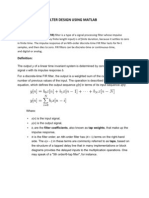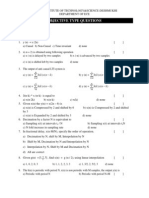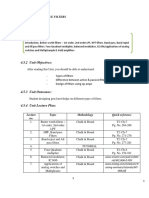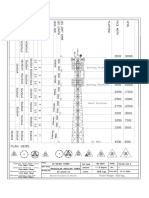Bartlett Window Using Matlab
Uploaded by
Anushree ShahdeoBartlett Window Using Matlab
Uploaded by
Anushree ShahdeoFIR FILTER USING BARTLETT WINDOW
AIM: To design an FIR filter using Bartlett window technique using MATLAB functions. THEORY: The N=point Bartlett window is given by
In the design of FIR filters using any window technique, the order can be calculated using the formula given by
where p is the passband ripple, s is the stopband ripple, fp is the passband frequency, fs is the stopband frequency and Fs is the sampling frequency. BARTLETTBartlett window: W = BARTLETT(N) returns the N-point Bartlett window. w = bartlett(L) returns an L-point Bartlett window in the column vector w, where L must be a positive integer. FIR1FIR filter designusingthe windowmethod: B = FIR1(N,Wn) designs an N'th order lowpass FIR digital filter and returns the filter coefficients in length N+1 vector B. The cut-off frequency Wn must be between 0 < Wn < 1.0, with 1.0 corresponding to half the sample rate. The filter B is real and has linear phase. The normalized gain of the filter at Wn is -6 dB. B = FIR1(N,Wn,'high') designs an N'th order highpass filter.You can also use B = FIR1(N,Wn,'low') to design a lowpass filter. If Wn is a two-element vector, Wn = [W1 W2], FIR1 returns an order N bandpass filter with passband W1 < W < W2. You can also specify B = FIR1(N,Wn,'bandpass'). If Wn = [W1 W2], B = FIR1(N,Wn,'stop') will design a bandstop filter. CEILRoundtowardsplus infinity. CEIL(X) rounds the elements of X to the nearest integers towards infinity.
MATLABCODE: %program for the design of FIR Low pass, High pass, Band pass and Band stop filters using Bartlett window clc;clear all;close all; format long rp=input('Enter the passband ripple'); rs=input('Enter the stopband ripple'); fp=input('Enter the passband frequency'); fs=input('Enter the stopband frequency'); f=input('Enter the sampling frequency'); wp=2*fp/f; ws=2*fs/f; num=-20*log10(sqrt(rp*rs))-13; dem=14.6*(fs-fp)/f; n=ceil(num/dem); n1=n+1; if(rem(n,2)~=0) n1=n; n=n-1; end y=bartlett(n1); %LOW PASS FILTER b=fir1(n,wp,y); [h,o]=freqz(b,1,256); m=20*log10(abs(h)); subplot(2,2,1),plot(o/pi,m); xlabel('Gain in dB--->'); ylabel('Normalised frequency--->'); title('LOW PASS FILTER'); %HIGH PASS FILTER b=fir1(n,wp,'high',y); [h,o]=freqz(b,1,256);
m=20*log10(abs(h)); subplot(2,2,2),plot(o/pi,m); xlabel('Gain in dB--->'); ylabel('Normalised frequency--->'); title('HIGH PASS FILTER'); %BAND PASS FILTER wn=[wp ws]; b=fir1(n,wn,y); [h,o]=freqz(b,1,256); m=20*log10(abs(h)); subplot(2,2,3),plot(o/pi,m); xlabel('Gain in dB--->'); ylabel('Normalised frequency--->'); title('BAND PASS FILTER'); %BAND STOP FILTER b=fir1(n,wn,'stop',y); [h,o]=freqz(b,1,256); m=20*log10(abs(h)); subplot(2,2,4),plot(o/pi,m); xlabel('Gain in dB--->'); ylabel('Normalised frequency--->'); title('BAND STOP FILTER');
SAMPLEINPUTS: Enter the pass band ripple.04 Enter the stop band ripple.02 Enter the pass band frequency 1500 Enter the stop band frequency 2000 Enter the sampling frequency 8000
OUTPUT:
RESULT:
An FIR filter was designed using Bartlett window technique by using MATLAB functions and the magnitude plots for low pass, high pass, band pass and band stop filters were obtained.
You might also like
- Write A Mat Lab Program To Perform Linear and Circular Convolution of The Discrete Time Sequences X50% (2)Write A Mat Lab Program To Perform Linear and Circular Convolution of The Discrete Time Sequences X26 pages
- EXP NO:07-a Date: Design of Fir Filter by Windowing TechniqueNo ratings yetEXP NO:07-a Date: Design of Fir Filter by Windowing Technique15 pages
- Lecture 04 - Signal Space Approach and Gram Schmidt ProcedureNo ratings yetLecture 04 - Signal Space Approach and Gram Schmidt Procedure20 pages
- Low-Pass Digital Filtering From RapidSTM32No ratings yetLow-Pass Digital Filtering From RapidSTM3223 pages
- Finite Impulse Response (FIR) Filter: Dr. Dur-e-Shahwar Kundi Lec-7No ratings yetFinite Impulse Response (FIR) Filter: Dr. Dur-e-Shahwar Kundi Lec-737 pages
- Signal: Continuous-Time Signal: Defined in A Continuous Range of TimeNo ratings yetSignal: Continuous-Time Signal: Defined in A Continuous Range of Time8 pages
- Chapter 15 - Digital Filter Design - Book - Programming DsPIC MCU in PASCAL - MikroElektronika1111No ratings yetChapter 15 - Digital Filter Design - Book - Programming DsPIC MCU in PASCAL - MikroElektronika11119 pages
- Techniques For Feature Extraction From EMG SignalNo ratings yetTechniques For Feature Extraction From EMG Signal4 pages
- Department of E.C.E.: Digital Communications Lab ManualNo ratings yetDepartment of E.C.E.: Digital Communications Lab Manual29 pages
- Real Time DSP: Professors: Eng. Julian Bruno Eng. Mariano Llamedo SoriaNo ratings yetReal Time DSP: Professors: Eng. Julian Bruno Eng. Mariano Llamedo Soria29 pages
- Designing A Lock-In Amplifier With Analog To Digital ConversionNo ratings yetDesigning A Lock-In Amplifier With Analog To Digital Conversion27 pages
- Signal Transmission Through Linear Systems100% (3)Signal Transmission Through Linear Systems16 pages
- E. Ambikairajah Australia: Part A: Signal ProcessingNo ratings yetE. Ambikairajah Australia: Part A: Signal Processing152 pages
- Signals & System Using Matlab - RIT PampadyNo ratings yetSignals & System Using Matlab - RIT Pampady45 pages
- Experiment No. 1: Objective: Write A MATLAB Program To Generate An Exponential Sequence X (N) (A)No ratings yetExperiment No. 1: Objective: Write A MATLAB Program To Generate An Exponential Sequence X (N) (A)53 pages
- Fir Filter Using Rectangular/Boxcar WindowNo ratings yetFir Filter Using Rectangular/Boxcar Window11 pages
- Fundamentals of Electronics 3: Discrete-time Signals and Systems, and Quantized Level SystemsFrom EverandFundamentals of Electronics 3: Discrete-time Signals and Systems, and Quantized Level SystemsNo ratings yet
- Service Manual: AV-21T14, AV-21T14, AV-21TG14100% (1)Service Manual: AV-21T14, AV-21T14, AV-21TG1429 pages
- AcuMesh Wireless RS485 Network User ManualNo ratings yetAcuMesh Wireless RS485 Network User Manual22 pages
- Nav 3 Topic 3 2019 A. Position Lines and PositionsNo ratings yetNav 3 Topic 3 2019 A. Position Lines and Positions27 pages
- Interdigital Comm. Corp. Title: Node B Synchronization Link Analysis Document For: Information and DiscussionNo ratings yetInterdigital Comm. Corp. Title: Node B Synchronization Link Analysis Document For: Information and Discussion3 pages
- Designing of A Miniature Radar System For Laboratory Use The DISPLAY SectionNo ratings yetDesigning of A Miniature Radar System For Laboratory Use The DISPLAY Section15 pages
- Mechanical Specifications: Non Ulls in The H-Pla NeNo ratings yetMechanical Specifications: Non Ulls in The H-Pla Ne1 page
- 13.1-Charactics of Light: Physics Revision Worksheet Name: ..Grade: 11 Section: . DateNo ratings yet13.1-Charactics of Light: Physics Revision Worksheet Name: ..Grade: 11 Section: . Date6 pages
- Amateur Radio Astronomy 7th Edition John Fielding - The ebook is ready for download, no waiting required100% (1)Amateur Radio Astronomy 7th Edition John Fielding - The ebook is ready for download, no waiting required57 pages
- Write A Mat Lab Program To Perform Linear and Circular Convolution of The Discrete Time Sequences XWrite A Mat Lab Program To Perform Linear and Circular Convolution of The Discrete Time Sequences X
- EXP NO:07-a Date: Design of Fir Filter by Windowing TechniqueEXP NO:07-a Date: Design of Fir Filter by Windowing Technique
- Lecture 04 - Signal Space Approach and Gram Schmidt ProcedureLecture 04 - Signal Space Approach and Gram Schmidt Procedure
- Finite Impulse Response (FIR) Filter: Dr. Dur-e-Shahwar Kundi Lec-7Finite Impulse Response (FIR) Filter: Dr. Dur-e-Shahwar Kundi Lec-7
- Signal: Continuous-Time Signal: Defined in A Continuous Range of TimeSignal: Continuous-Time Signal: Defined in A Continuous Range of Time
- Chapter 15 - Digital Filter Design - Book - Programming DsPIC MCU in PASCAL - MikroElektronika1111Chapter 15 - Digital Filter Design - Book - Programming DsPIC MCU in PASCAL - MikroElektronika1111
- Department of E.C.E.: Digital Communications Lab ManualDepartment of E.C.E.: Digital Communications Lab Manual
- Real Time DSP: Professors: Eng. Julian Bruno Eng. Mariano Llamedo SoriaReal Time DSP: Professors: Eng. Julian Bruno Eng. Mariano Llamedo Soria
- Designing A Lock-In Amplifier With Analog To Digital ConversionDesigning A Lock-In Amplifier With Analog To Digital Conversion
- E. Ambikairajah Australia: Part A: Signal ProcessingE. Ambikairajah Australia: Part A: Signal Processing
- Experiment No. 1: Objective: Write A MATLAB Program To Generate An Exponential Sequence X (N) (A)Experiment No. 1: Objective: Write A MATLAB Program To Generate An Exponential Sequence X (N) (A)
- Fundamentals of Electronics 3: Discrete-time Signals and Systems, and Quantized Level SystemsFrom EverandFundamentals of Electronics 3: Discrete-time Signals and Systems, and Quantized Level Systems
- Nav 3 Topic 3 2019 A. Position Lines and PositionsNav 3 Topic 3 2019 A. Position Lines and Positions
- Interdigital Comm. Corp. Title: Node B Synchronization Link Analysis Document For: Information and DiscussionInterdigital Comm. Corp. Title: Node B Synchronization Link Analysis Document For: Information and Discussion
- Designing of A Miniature Radar System For Laboratory Use The DISPLAY SectionDesigning of A Miniature Radar System For Laboratory Use The DISPLAY Section
- Mechanical Specifications: Non Ulls in The H-Pla NeMechanical Specifications: Non Ulls in The H-Pla Ne
- 13.1-Charactics of Light: Physics Revision Worksheet Name: ..Grade: 11 Section: . Date13.1-Charactics of Light: Physics Revision Worksheet Name: ..Grade: 11 Section: . Date
- Amateur Radio Astronomy 7th Edition John Fielding - The ebook is ready for download, no waiting requiredAmateur Radio Astronomy 7th Edition John Fielding - The ebook is ready for download, no waiting required

























































































